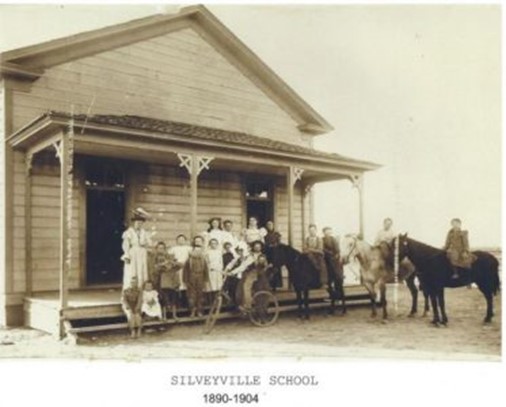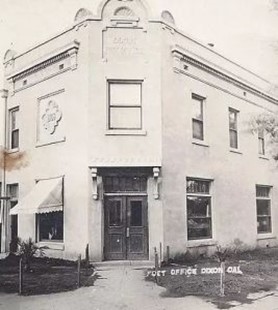DIXON
The first settlement in the Dixon area was founded in 1852 by ELIJAH S. SILVEY, whose search for gold landed him in these parts during the California Gold Rush. Silvey realized an easier way to make his fortune was to open an inn and saloon rather than mining for gold. This halfway house was located along a well-traveled stagecoach route to the goldfields of the Sacramento region and became famous among area miners. By 1865, the community of Silveyville boasted a general store, a church, a post office, a blacksmith and had a population of 150 people.
The Vaca Valley Railroad was about to inaugurate its new line in Solano County in 1870. However, residents of Silveyville were not happy when they learned that the tracks would not cross into their town. The tracks did, however, cross the land of MR. THOMAS DICKSON. As a result, local leaders decided to physically relocate Silveyville closer to the tracks to enjoy the benefits of commerce and travel. With Dickson in charge of the re-location, pioneers started what is now known as the Downtown Dixon area.
PETER TIMM, a cabinetmaker, who had recently arrived from Denmark, moved the Silveyville buildings on large flat cars with wooden rollers, like telephone poles, closer to the railroad tracks.


Dixon Post Office
The California Pacific Railroad tracks were almost finished and a train station was needed. At the same time, Dickson donated 10 acres of his land for the new depot, with a city, “Dicksonville,” to be named after himself. The first rail shipment of merchandise from San Francisco arrived in 1872, mistakenly addressed to “Dixon,” and that spelling stuck.
In 1874, after nearly a two-year push to have the town officially named “Dicksonville,” the County Recorder filed with the name “Dixon” on the new maps, stating it was "simpler."
On November 19, 1883, a horrible fire started in the kitchen of the old Centennial Hotel, which almost completely destroyed the town. Many residents suffered loss; most businesses, including the town’s saloons and six churches, were all but destroyed in just a few hours. After the fire, the building materials of choice became brick or tin, as part of a new city ordinance. The first firehouse was built in 1891 on Jackson Street, as was the very first jailhouse, located next to the firehouse.
In 1885, a great deal of interest was being generated in horse harness racing. A group of gentlemen formed the Dixon Driving Park Association. The group purchased a 20-acre tract of land from PETER N. PETERS and proceeded to construct a horse racing track and pavilion, which, in 1886, became the site of the annual May Day celebration.
In 1916, Dixon was the site of the Solano County Fair, indicating what a popular event horse racing had become. In 1933, the State of California legalized racehorse betting. The May Day manager, WATSON KILKENNY, was responsible for Dixon’s receiving a share of the wagering money.
In 1899, the Capitol Hotel opened on the corner of First and A Streets. By 1908, the owners of DAWSON’S Cigar Store were the first to serve beer in Dixon.
In the early Dixon days, baseball was also a favorite sport. Baseball, in those days, ran in families. By the late 1880s and early 1900s, it was the ROHWER and VAN SANT families who brought fame to Dixon with participation in local and league baseball, playing on dirt fields and traveling by horse drawn vehicles to games.
Dixon was also known in the early 1900s as “The Dairy City.” During this period, farming emphasized growing crops essential to successful dairying along with pure water, temperate climate, and clean surroundings. TIMM Certified Dairy, was originally known as the “World’s Largest Certified Dairy.” By 1920, Dixon had some thirty dairy family farmers in addition to TIMM, including GILL, NUNES, GEORGE, BELLO, ROWE, BRAZIL, PERREIRA, AZEVEDO, BULKLEY AND DUTRA. KARL A. HESS originated Dixon’s famous “Milk Farm” in 1919. During the depression, HESS offered pony rides, and “all you can drink” milk for 10 cents.
Online Resources: